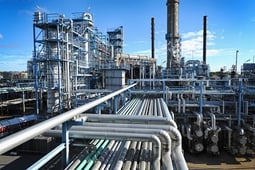In many piping systems, steady-state flow is only part of the story. Before normal operation begins – or after it ends – fluid networks often experience dramatic transitions: systems start empty and fill with liquid, lines are drained, and purge sequences move compressible gases through pipelines. Along the way, gas pockets and liquid-gas interfaces form and move throughout the network.
With the new Pipe Filling and Draining feature in Impulse, engineers can now simulate these dynamic scenarios with more accuracy than ever before.
Simulating the Movement of Gas-Liquid Interfaces
At the core of Pipe Filling and Draining is the ability to track gas-liquid interfaces – like air pockets or bubbles – as they move through a piping network. These interfaces may appear during startup, shutdown, or deliberate operations such as gas purging. In any case, they can strongly influence system performance, surge behavior, and mechanical stress.
To model this accurately, Pipe Filling and Draining uses a hybrid approach:
- The Method of Characteristics (MOC) is used to model the liquid and the interface, capturing transient pressures and wave propagation.
- A bulk compressible volume model is used for the gas side, allowing bubbles to expand or contract in response to surrounding conditions.
This combination provides a realistic view of how systems fill, drain, and respond to rapid transitions.
Real-World Engineering Applications
Impulse has always been a tool for transient analysis. What’s new is that Pipe Filling and Draining extends this capability to include transients involving gas-liquid interfaces – a common real-world phenomenon that was previously difficult to capture. Here are a few examples of how this applies across industries:
Startup and Commissioning
Pipelines in water distribution systems, fire protection networks, or chemical plants often begin empty. The Pipe Filling and Draining feature enables simulation of startup sequences, showing how quickly a system will fill and how pressure waves evolve during that time. This helps engineers plan startup procedures and anticipate surge and water hammer during initial pressurization.
Shutdown and Draining
When lines are drained – intentionally or due to depressurization – gas-liquid interfaces form and migrate. This feature allows engineers to predict draining speed and assess whether transient forces might compromise equipment or pipe supports.
Gas Purging and Air Pocket Movement
In oil and gas pipelines, industrial cleaning, or batch operations, gas is often introduced to the system to push liquid or separate product stages. Pipe Filling and Draining makes it possible to simulate how bubbles move, expand, and affect system pressures – allowing engineers to optimize purge strategies and gas usage.
Surge and Force Estimation
Even in systems where gas isn’t deliberately added, trapped pockets can occur. These bubbles may create significant transient forces when displaced. With the Pipe Filling and Draining feature, engineers can model what occurs after trapped gas is accumulated explicitly, improving estimates of the forces acting on pipes, valves, and supports.
Design Optimization
By capturing the dynamics of filling, draining, and purging, engineers can test whether pumps, valves, and other system components are correctly sized. This leads to smarter designs and more effective surge control strategies.
What Makes It Different
Most surge analysis tools assume fully liquid systems. Approximations for startup or draining exist, but they rarely capture how compressible gases interact with transient liquid flow.
Pipe Filling and Draining goes further by explicitly modeling gas-liquid interfaces. This enables engineers to:
- Simulate the expansion and compression of bubbles as they move.
- Track the location and size of interfaces through time.
- Account for surge effects generated during rapid filling, draining, or purging.
- Visualize transient behaviors that would otherwise be difficult to estimate.
Modeling Assumptions and Guidance
To provide practical results, the feature uses a simplified but effective physical model:
- Interfaces are assumed to be perpendicular to the pipe and move at the liquid velocity.
- Gas is modeled as a uniform, compressible volume, not accounting for internal gradients or stratification.
- Acoustic disturbances within the gas are ignored.
- Gas is not entrained in the liquid, and two-phase mixing is not simulated.
For improved resolution, engineers are encouraged to use finer pipe sectioning – about ten segments per pipe.
Some constraints apply: Pipe Filling and Draining is not compatible with cavitation modeling, infinite pipes, variable fluids, or Pulsation Frequency Analysis. Additionally, liquid and gas flows may not mix at branches. During initialization, each pipe can only contain a single interface, though once the simulation begins, bubbles can split and propagate as the system evolves.
How Pipe Filling and Draining Represent Bubbles
Unlike cavitation models such as DVCM and DGCM, bubbles in Pipe Filling and Draining are treated as stable interfaces that do not collapse. Instead, they can split, expand, contract, or enter the system through air valves, reflecting real-world filling and draining behavior. Interfaces are removed only when a bubble exits through a gas vent junction, and junction conditions govern how this occurs. For example, if an air valve is connected to two pipes and receives liquid from one and gas from the other, the solver will produce an error, since the valve cannot process both simultaneously. Likewise, bubbles remain distinct; they do not merge when flow reverses, which ensures interface behavior is modeled consistently.
A More Complete View of System Dynamics
The Pipe Filling and Draining feature fills a critical gap in surge modeling. Capturing startup, shutdown, and purge events with realistic treatment of gas-liquid interfaces it gives engineers a more complete picture of how systems behave before and after steady operation.
For engineers designing and operating fluid networks, this means better insight into surges, forces, and interface behavior – and ultimately, safer and more efficient systems.
With Pipe Filling and Draining, Impulse makes it easier than ever to model what really happens when a system comes to life, winds down, or goes through a purge. It’s a powerful addition to the engineer’s toolbox and a big step forward in connecting simulation to reality.






